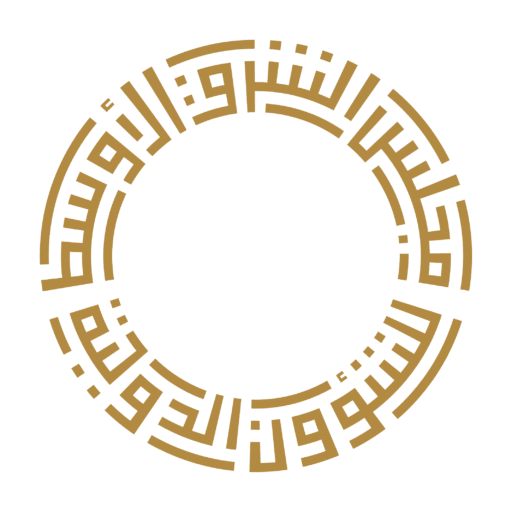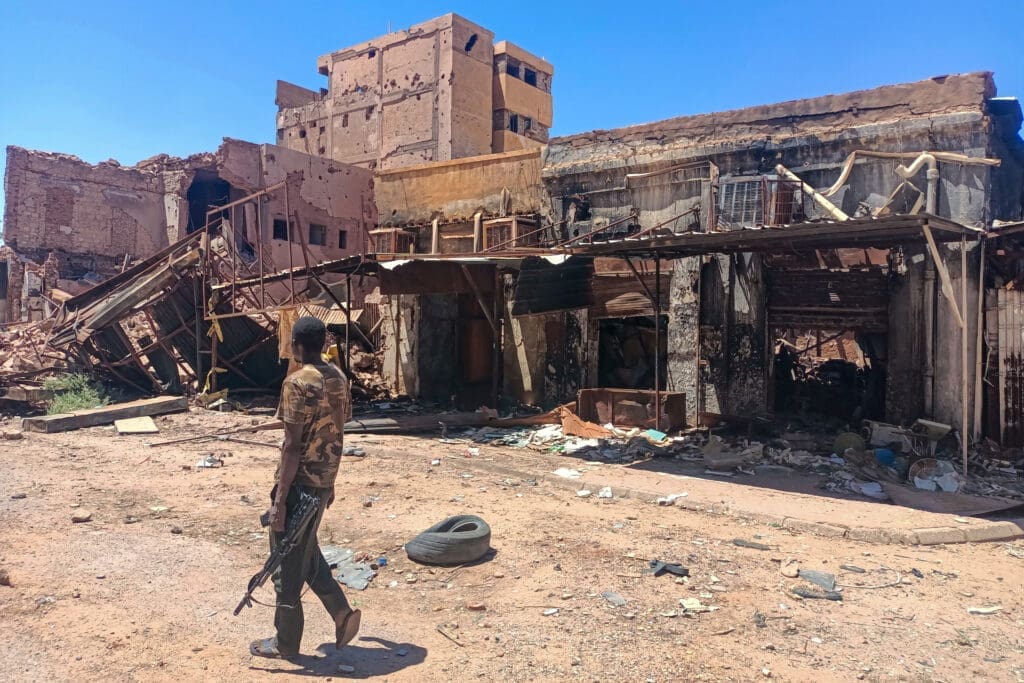As Sudan’s brutal civil war enters its third year, political and military developments on the ground have sparked speculation that a turning point may be near. But a closer look reveals a bleaker reality: an end to the conflict, whether through a political settlement or military victory, remains distant. More worrying, the recent shifts have cloaked a variety of devastating realities that are becoming normalized and threatening the fabric of the Sudanese state: rampant ethnic discrimination, the collapse of the civil space, and the emboldening of armed groups and leaders.
Meanwhile, instability on Sudan’s southern border in South Sudan, an uncoordinated international approach to bringing about an end to the war, and the deep geopolitical interests of external actors inside the country have contributed to the increasing complexity of the conflict.
The war in Sudan is as much a fight for legitimacy as it is for military victory. In this context, both the warring parties—the Sudanese Armed Forces (SAF) and the paramilitary Rapid Support Forces (RSF)—have become experts in crafting and promoting their narratives of statehood, seeking out alliances that can strengthen their positions, and making themselves valuable to actors who can provide arms and backing.
State of Play
The war’s outbreak in April 2023 was the manifestation of a brewing power struggle that existed between the SAF and the RSF. This had been maintained by an uneasy power-sharing agreement following the October 2021 coup, wherein the army arrested civilian members of a power-sharing transitional council that was established following the 2019 revolution. In the war’s early stages, the RSF maintained control over significant parts of western, central and northern Sudan, including key areas of the capital, Khartoum.
That changed in late March 2025 when, after months pursuing an offensive strategy bolstered by support from allied armed groups, the SAF was able to retake critical areas in Khartoum, including the presidential palace and the international airport, effectively declaring the capital free of RSF. This marked a significant shift of momentum following a long period of entrenchment and attrition. Since then, leaders of both armed forces have vowed to continue fighting until they crush the other.
Naturally, Khartoum remains a symbolic crown—the control of which signifies, at least on the surface, who holds the upper hand. Nonetheless, the RSF continues to control vast territories in western Sudan’s Darfur and Kordofan regions, where violence remains relentless. These areas have seen mass killings, ethnic targeting and sexual violence by RSF and allied militias. The SAF-controlled city of El-Fasher is under siege, with civilians enduring hunger, artillery fire and drone strikes.
Additionally, SAF operations in western Sudan have largely been conducted through aerial warfare, which has devastated infrastructure, displaced tens of thousands, and resulted in many casualties. The RSF, following its retreat from Khartoum, has sought to consolidate its positions in the west. In response, the SAF does not appear to be considering other tactics—such as launching a ground attack—meaning that indiscriminate casualties and violence will likely continue to soar. This new configuration complicates alliances, increases ethnicization, reinforces a de facto East-West divide, and has dangerous implications for normalizing or fueling conversations of partition.
In the meantime, brewing internal tensions in neighboring South Sudan have introduced new possibilities for an explosive convergence of conflicts. In March, allegations surfaced that the RSF deliberately disrupted a key oil pipeline transporting South Sudanese crude oil through Sudan, crippling Juba’s economy. This forced President Salva Kiir to engage with the RSF—infuriating Port Sudan authorities, while giving the RSF a potential foothold in South Sudan. The RSF could now exploit this relationship to expand smuggling routes and launch operations into central and northern Sudan. In response, the SAF is expected to back Kiir’s domestic rivals, risking the development of a dangerous proxy dynamic. The two wars may soon become dangerously intertwined with hard-to-predict outcomes.
Tearing at the Fabric
These military dynamics are accompanied by the unilateral political visions recently set out by both parties. In early 2025, SAF chief Abdel Fattah al-Burhan announced a 39-month military-led transition plan that would culminate in elections—a move that amounts to a de facto military government. He also tasked some judicial figures with overseeing this transition, one that includes the stated goal of “clearing Sudan of rebels.” In contrast, the RSF and its allies, including those from the civilian camp, unveiled a “Transitional Peace Government” charter in Nairobi in February 2024. It promises secular governance, a bill of rights, regional autonomy and a unified national army.
Another underreported consequence of the conflict is the proliferation of armed groups. The SAF holds the support of key militias, such as the Al-Baraa Bin Malik Brigade and the Sudan Shield Forces in the east, which was once aligned with the RSF. For its part, the RSF has secured support from factions like the Sudan Liberation Movement and the Justice and Equality Movement, whose leaders endorsed the Nairobi charter. Sudan is no stranger to armed actors who leverage violence for concessions from the center, but their growing influence and role in core military operations mean they will almost certainly demand a share of the national pie in any post-war future. Without clear plans for pursuing security sector reform, disarmament and reintegration into the national army, Sudan risks replacing one set of militias with another—perpetuating the same dynamics that gave rise to the RSF.
Under the cloud of war, civic space, too, is under siege. Civilian networks, particularly Emergency Response Rooms (ERR)—a community-led initiative for the provision of humanitarian aid—and professional unions, have reported systematic targeting by both the SAF and RSF. The Sudan Doctors Syndicate has voiced concern over the detainment of its medical staff in retaken areas of the Jazirah region by the SAF. Similar incidents have occurred under RSF control.
Ethnic targeting and summary executions are increasingly common, even being carried out by unidentified militias or allied forces. In a war where control of territory frequently shifts, accusations of treason have become dangerously fluid—subject to the whims of whoever holds power at the time. It also raises critical questions, such as: in a war where many have had to engage or assist either side in order to secure their safety, manage their aid work, or secure the most basic needs, how can you measure what is an act of treason? The rampant lack of due process lays the foundation for a dangerous precedent of impunity for all actors who have the arms to undertake such killing.
Furthermore, in light of this widespread repression, questions over what sort of civic landscape will be left after the war and the implications this has for a democratic political future become paramount. The widespread aid cuts pursued by various international donors also mean that many of these key civil society groups that have been on the front lines providing life-saving assistance will be unable to operate. For example, after the Trump administration’s freeze of USAID, the number of functioning community kitchens in Sudan reportedly dropped from 1,460 to just 324.
A Failure to Help
Despite repeated international mediation attempts, peace remains elusive. Most recent coordinated efforts focus on responding to the humanitarian crisis—as represented by the upcoming high-level donor conference hosted by the United Kingdom, European Union, France and Germany, which is set to take place on April 15 in London. Western-led sanctions, on the other hand, which have been placed on companies and individuals linked to both sides, have had limited effect.
The warring parties have already concentrated their attention toward the Gulf and wider Middle East, where key backers continue to provide political and material support—often with the tacit approval of their Western allies. Unless efforts are made to curtail the illicit financial and arms networks that are fueling the war machine, punitive measures will remain symbolic at best, and the horrors of the war will continue to spread.
As calls for an end to the war intensify due to an exhausted and traumatized civilian population that continues to bear the brunt, belligerents are still clinging to the prospect of military victory. In this context, addressing the root causes of this war through security reform, economic diversification and inclusive civilian political participation has been sidelined, at best, or co-opted and deemed unrealistic for Sudan’s future, at worst. The war has ravaged all 18 of Sudan’s states, and clear, indisputable evidence that an end is near has yet to materialize. But the war will eventually be over, and with its conclusion, all must reckon with a deeper question: Given the stifling of Sudan’s civic space, the rise of armed groups, the destruction of infrastructure, and the erosion of social cohesion, what sort of post-war state will exist?
The opinions expressed in this article are those of the author and do not necessarily reflect the views of the Middle East Council on Global Affairs.


